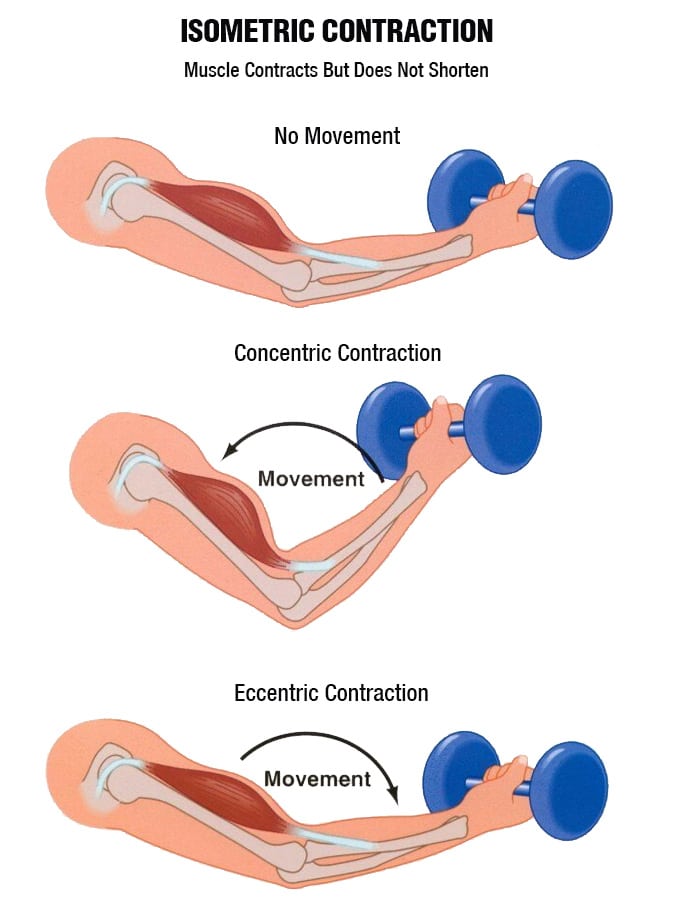Your training time and energy are valuable, and I don’t believe you should waste them on ineffective workouts. As such, I’ve spent a lot of my 30-plus-year career as a personal trainer looking for the most effective ways to build muscle mass, strength, and fitness.
That’s not to say that I think there are shortcuts to building getting in shape – there aren’t. Everyone, even so-called easy gainers, must pay their dues in the gym and pay attention to their diets if they want to make the best possible progress.
However, there are numerous ways to make your workouts even more efficient.
Things like supersets and drop sets are particularly potent, and lengthened partials and blood flow restriction training (BFR) also show a lot of promise.
One of the most effective workout boosters I know is also the most accessible – isometrics. In most cases, isometrics will bolt seamlessly onto your existing workout and don’t require much extra training time or equipment.
And yet, despite this minimal extra investment, adding isometrics to your workouts can make your training much more productive.
Level Up Your Fitness: Join our 💪 strong community in Fitness Volt Newsletter. Get daily inspiration, expert-backed workouts, nutrition tips, the latest in strength sports, and the support you need to reach your goals. Subscribe for free!
In this article, I reveal my favorite strategies for combining isometrics with conventional training so you can get even more from your workouts.
What Are Isometrics?
We usually associate muscle contractions with movement. For example, concentric contractions cause your muscles to shorten to generate force, such as the lifting part of a biceps curl.
In contrast, muscles can also generate force as they lengthen. This is called an eccentric contraction, such as descending into a squat.
Most exercises involve a concentric AND an eccentric phase, although which comes first depends on the movement you are performing. For example, bench presses start with an eccentric contraction, while lat pulldowns start with a concentric contraction.
However, there is a third type of contraction where muscles generate force but do not produce any movement. These are called isometric contractions. Isometric exercises tax your muscles, but you do not lift or lower a load. As such, these are also known as static exercises.

In most cases, isometrics involve pushing or pulling against an immovable object, such as an ultra-heavy weight, a wall, a towel, or a yoga strap. Contrastingly, isometrics can also involve holding a weight in a set position.
Isometric exercises are not new, and you are already probably familiar with a few, such as abdominal planks and wall-sits. However, there are plenty more isometric exercises you can do.
- Related: The Science of Isometric Training — Explained!
- Related: Isometrics for Injury Prevention and Building Strength and Muscle
Isometric Training
Isometric training provides a unique training stimulus, and, as such, you can use it to add variety to your conventional strength and muscle-building workouts. Numerous studies support the use of isometrics, and they’ve been shown to provide similar benefits to standard exercises (1, 2).
However, that doesn’t mean you should replace your regular workout with isometrics. While they are undeniably effective, training solely with static exercises is probably not the best way to reach your physique or athletic performance goals.
That said, isometrics is a powerful training tool you can use to supercharge your workouts. Depending on how you use them, isometrics can make your workouts safer, more effective, or more time-efficient. In short, they’re a great add-on and not a replacement for your usual training program.
In the next section, I reveal the best strategies for adding isometrics to your workouts.
Three Ways to Supercharge Your Workouts with Isometrics
Isometric-only workouts can be effective, but only under certain circumstances. For example, isometric exercises can be helpful for working around joint injuries, preserving muscle during a layoff, or when you can’t make it to the gym to lift weights.
Your body adapts to the type of training you do, so if you do a lot of isometric training, your muscles will get very good at producing forces statically. As such, your gains may not transfer to dynamic movements.
However, that doesn’t mean you should write isometrics off as useless. In fact, they may help you get more out of your regular strength and muscle-building workouts.
Here are three proven ways to incorporate isometrics into your training.
1. Isometrics in Your Warm-Up
Any good workout starts with a thorough warm-up. Warming up prepares your muscles and joints for the work you’re about to do, potentially lowering your risk of injury.
Most effective warm-ups include the following components:
- Pulse raiser – 5-10 minutes of light cardio.
- Joint mobility – to lubricate joints and reduce wear and tear.
- Dynamic flexibility – to improve functional range of motion.
However, getting your body warm is only part of what you need to do before starting your workout. You must also get your muscles and nervous system working efficiently so you can generate maximal muscular force.
In my experience, one of the most effective ways to do this is with isometrics.
For that reason, I always include isometrics in my warm-ups. Simply perform 2-3 sets of an appropriate isometric exercise for the muscles you are about to train. This will wake them up and make your consequent workout more effective.
For example, before starting your chest workout, do a couple of sets of isometric towel presses to fire up your pecs, delts, and triceps. Alternatively, on back training day, get your lats and biceps ready with a couple of sets of isometric towel rows.
2-3 sets of 10-20 seconds at 60-80% of maximal contractile force should be enough to increase muscle activation without tiring you out.
2. Isometric/Dynamic (Iso/Dyno) Supersets
Iso/dyno supersets are one of my favorite ways to combine static with dynamic training. You can do the isometric exercise first, which is a form of pre-exhaust training, or do the dynamic exercise first for a twist on post-exhaust training.
Both methods expose the target muscles to more work than usual, delivering more of the muscle-building stimulus they need to grow. As such, this is an excellent option for bodybuilders and other exercisers looking to maximize muscle size.
Here are a few examples to try, but I’m sure you’ll have no problem coming up with plenty of your own.
Level Up Your Fitness: Join our 💪 strong community in Fitness Volt Newsletter. Get daily inspiration, expert-backed workouts, nutrition tips, the latest in strength sports, and the support you need to reach your goals. Subscribe for free!
Perform the first exercise close to failure, and then move immediately to the second exercise and do that one close to failure, too. Try switching the order of the exercises (isometrics first vs. conventional exercise first) to see which you prefer.
- Isometric wall squat – 20-30 seconds
- Leg press – 12-15 reps
- Biceps cable curl – 8-12 reps
- Isometric biceps curl – 20-30 seconds
- Isometric doorway lateral raise – 20-30 seconds
- Seated dumbbell shoulder press – 12-15 reps
- Isometric reverse plank – 20-30 seconds
- Romanian deadlift – 8-12 reps
3. Isometric Finishers
With no weights to drop, isometric exercises are the perfect choice for training to failure. As such, they are ideal finishers after your main conventional workout is complete. Using isometrics means you can wring every last bit of energy from your target muscles without risking injury.
My favorite protocol for this involves doing three 10-second holds with 5 seconds between each for three sets.
This breaks down as such:
- 10-second isometric contraction (80% maximal force production)
- 5-second rest
- 10-second isometric contraction (90% maximal force production)
- 5-second rest
- 10-second isometric contraction (1000% maximal force production)
- 60-second rest and then repeat the entire sequence twice more
Taking less than five minutes, isometric finishers are a great way to ensure you don’t leave any gains on the table, even if the rest of your workout didn’t go as planned. Simply do one isometric exercise for the muscle you want to finish off.
FAQ’s
Do you have a question about adding isometrics to your conventional strength training workouts? No problem, because I’ve got the answers! Need more information? Please drop me a line in the comments section below, and I’ll get back to you ASAP.
1. What is the ideal contraction time for isometrics?
The ideal contraction time for isometrics depends on what you are training for. In general, short holds, i.e., 5-10 seconds, are ideal for increasing muscle activation and developing muscle strength and power. In contrast, longer holds of 20-30 seconds are better for muscle hypertrophy and endurance.
With both variations, you should push or pull as hard as you can so that your muscles are close to failure by the end of the allotted time.
2. What is the difference between yielding and overcoming isometrics?
Broadly speaking, there are two types of isometric training – yielding and overcoming.
With yielding isometrics, you lift and then hold a weight without moving. Isometric biceps holds and planks are examples of this. With these exercises, the goal is to maintain muscle tension for as long as possible.
In contrast, overcoming isometrics involves applying force against an immovable object, such as a wall, yoga strap, iso-trainer, or an opposing limb. With an infinite amount of resistance available, overcoming isometrics are generally best for building muscle and strength. In contrast, yielding isometrics are better for general fitness and muscular endurance.
Personally, I prefer overcoming isometric exercises because they allow you to fatigue your muscles in a more time-efficient way. Yielding isometrics can often take a long time to reach muscular failure, e.g., when doing planks for minutes at a time. Plus, you’ll invariably need an external load for your chosen exercise, making them less accessible for some people.
3. Are isometrics safe for everyone?
Of all the strength and muscle-building tools we have access to, isometrics is one of the safest. With no movement, there is very little stress on the joints, and the chances of muscular injury are also very low. Additionally, if you choose overcoming isometric exercises, there are no weights to drop, even if you push your muscles to failure.
However, that doesn’t mean that isometrics are 100% safe. You can still strain a muscle if you contract too hard or fail to warm up before your workout. Also, isometric exercises tend to increase blood pressure more than most conventional movements. As such, they may be inadvisable for people with severe hypertension (3).
However, it’s also worth noting that while isometric exercises can cause a temporary increase in blood pressure, isometric training can be an effective way to manage and reduce blood pressure in otherwise healthy individuals (4).
4. How can I use Isometrics to boost my performance in the “big lifts?”
Powerlifters sometimes use isometrics to help them build strength in a specific range of motion, usually at their sticking points for the squat, bench press, and deadlift.
To do this, position the barbell at the required height and load it with more weight than you can lift. Alternatively, set the safety bars in your power rack to stop the barbell from moving.
Next, get under the bar and push or pull against it as hard as possible for 5-10 seconds. With repeated applications, you’ll improve your strength in this position so you can blast through your sticking points.
Here are three videos showing you how to do this for the squat, bench press, and deadlift:
Squat:
Bench Press:
Deadlift:
5. What are some of the limitations of isometric training?
On the whole, isometric training should be safe and effective for most people. I’ve been using it with my clients for many years, and it was also part of my powerlifting workouts. However, there are a few drawbacks to consider, the most notable being:
Unquantifiable workouts – with no weights or reps to count, you can’t put any numbers to your workouts. All you can do is contract your muscles for a set amount of time. This means that improvements in isometric strength are impossible to quantify unless you use a force plate or similar.
Strength gains are angle-specific – contracting your muscles at, for example, 90 degrees of elbow flexion will build strength at that angle and about 15 degrees on either side. It won’t build full-range strength. As such, you may need to do several reps at different joint angles to develop strength through the full range of motion.
Closing Thoughts
Building strength and muscle mass often seem like complicated processes. However, when you get down to it, effective training is usually a matter of hard, consistent work. Complex training methods are usually no better than more straightforward workouts and exercises.
And that’s one of the reasons I’m such a big fan of isometrics. After all, at its core, this method is as simple as pushing or pulling against an immovable object.
And yet, despite this simplicity, adding isometrics to your workouts could have a profound effect on your strength and muscle gains. Use isometrics in your warm-up, main session, or finisher to make your training as effective and efficient as possible.
So, while I don’t think you should drop dynamic strength training in favor of isometrics, I do believe that adding isometric exercises to your current workout could make it even more productive.
References:
- Oranchuk DJ, Storey AG, Nelson AR, Cronin JB. Isometric training and long-term adaptations: Effects of muscle length, intensity, and intent: A systematic review. Scand J Med Sci Sports. 2019 Apr;29(4):484-503. doi: 10.1111/sms.13375. Epub 2019 Jan 13. PMID: 30580468.
- Adams GR, Cheng DC, Haddad F, Baldwin KM. Skeletal muscle hypertrophy in response to isometric, lengthening, and shortening training bouts of equivalent duration. J Appl Physiol (1985). 2004 May;96(5):1613-8. doi: 10.1152/japplphysiol.01162.2003. PMID: 15075307.
- Hanson P, Nagle F. Isometric exercise: cardiovascular responses in normal and cardiac populations. Cardiol Clin. 1987 May;5(2):157-70. PMID: 2884033.
- Baffour-Awuah B, Pearson MJ, Dieberg G, Wiles JD, Smart NA. An evidence-based guide to the efficacy and safety of isometric resistance training in hypertension and clinical implications. Clin Hypertens. 2023 Mar 15;29(1):9. doi: 10.1186/s40885-022-00232-3. PMID: 36918919; PMCID: PMC10015931.
Article Updates Timeline:
Our editorial team experts constantly update the articles with new information & research, ensuring you always have access to the latest and most reliable information.
February 6, 2024
Written By
Patrick Dale, PT, ex-Marine
Reviewed By
Editorial Team










